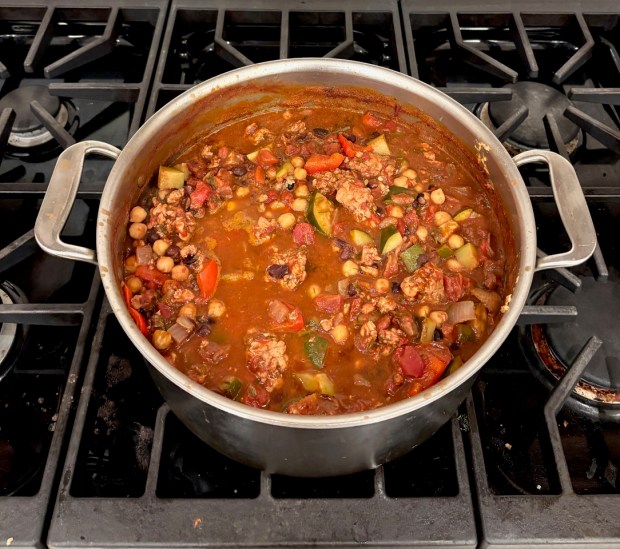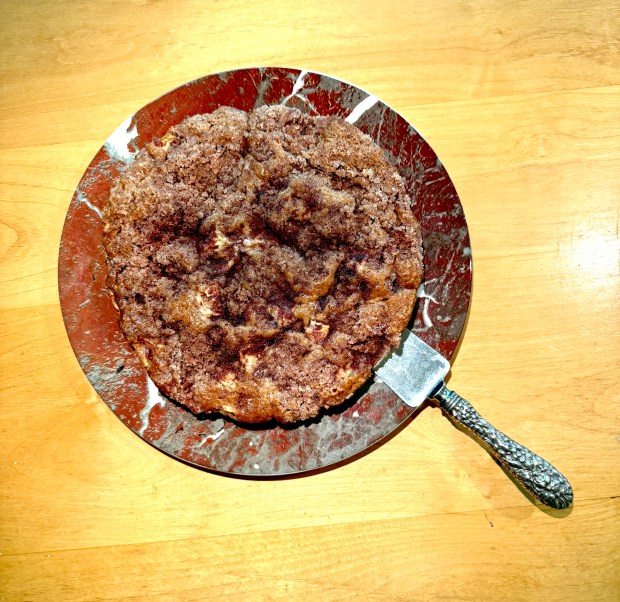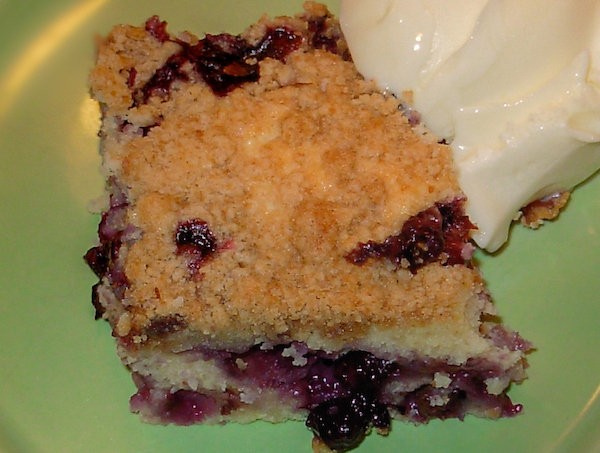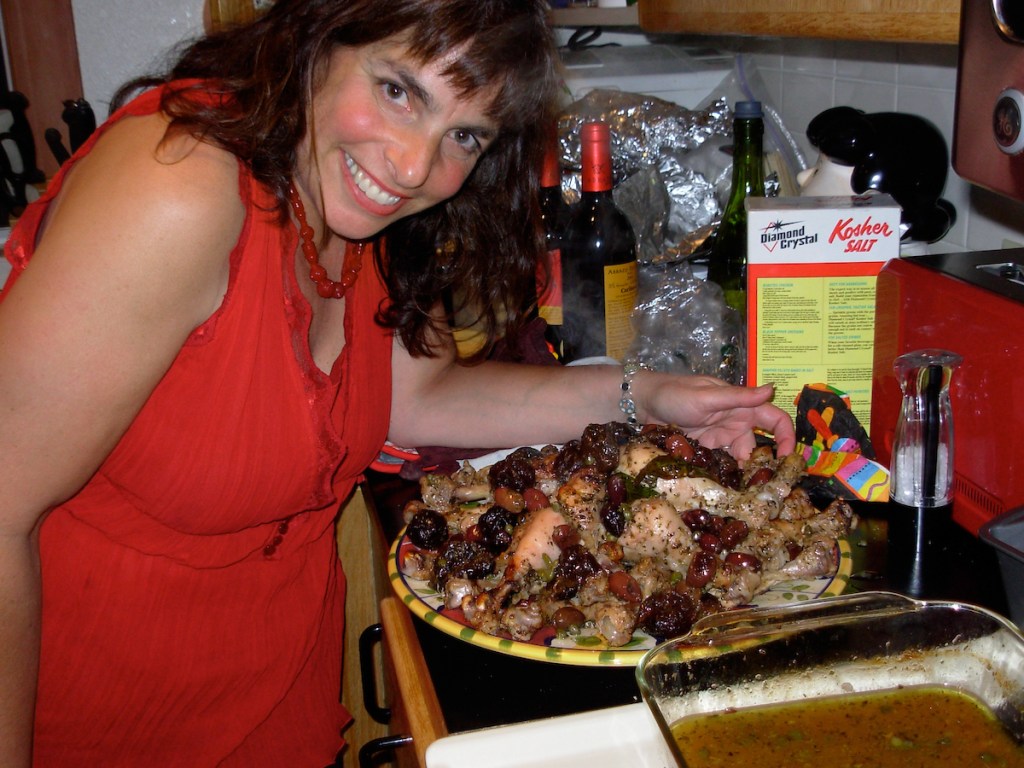Mill Valley resident Suz Lipman made this chicken Marbella. (Photo by Suz Lipman)

Mill Valley resident Barbara Sobel first started making this chocolate chili during Halloween. (Photo by Barbara Sobel)

Mill Valley resident Collette Sell loves to make this vegan apple cinnamon cake. (Photo by Collette Sell)

“We discovered blueberry buckles during a trip to Maine, where they are a specialty. Buckles became a favorite in our house after that,” said Mill Valley’s Suz Lipman. (Photo by Suz Lipman)

(Courtesy of Mill Valley Public Library)
Show Caption
1 of 5
Mill Valley resident Suz Lipman made this chicken Marbella. (Photo by Suz Lipman)
Expand
A meatloaf recipe made for a veteran coming home from Vietnam. A casserole dish full of comfort on cold nights. These are just some of the recipes found within the pages of the new “Mill Valley Community Cookbook,” an eclectic collection of recipes and the sweet, funny and historic stories behind them by former and current Mill Valley residents.
Created by the Mill Valley Public Library, with support from the Mill Valley Library Foundation and Friends of the Mill Valley Public Library, the cookbook launched earlier this month with a potluck featuring many of the cookbook’s participants. A limited number of free copies are available at the library for people to come and take, and copies of the cookbook will be added to the library’s collection for people to check out.
“Each recipe comes with a short story about why this recipe means something to someone. You’re not just getting a recipe. You’re getting someone’s personal history, which is the most important component for me. Food is wonderful, and food can tell you so much about a person or about a culture, and it’s about the connection that people here in Mill Valley have to food and exploring that and sharing it with others,” said Jennifer Hooker, the library’s adult services supervising librarian, who worked with supervising librarian and archivist Natalie Snoyman and others to bring it to life.
“At the potluck, people were enjoying the food and sharing stories about food, and people were making new friends. I’m like, this is why I do what I do. This is what I wanted to come out of this project.”
For Marilyn L. Geary, history has always played a big part in her life. She worked at the Anne T. Kent California Room, an archive dedicated to collecting, preserving and interpreting the history and culture of Marin County, for many years doing oral histories and served on the Mill Valley Historical Society’s board. So, when Geary, who moved back to Mill Valley from Woodacre around a year ago, heard about the cookbook project, she went on a search for a historical recipe to submit. Combing through the California newspaper digital archives, she stumbled upon Mrs. Carl Symonds and her bran muffins and knew she’d found her winner.
Originally published in the Mill Valley Record on March 2, 1918, she was the U.S. Food Administration’s local woman food administrator and encouraged Mill Valley homemakers to conserve wheat and sugar so that they could be shipped overseas for our troops and allies during World War I.
“I hope to honor the women who played their part on the home front, using their kitchens as a way to support a greater cause. This recipe serves as a reminder that our kitchens are more than places to cook; they are places to record, preserve and share stories of resilience and community,” Geary said.
And when she decided to try to make the muffins herself, she soon realized how cooking has changed since then.
“Making it was fun because there were a lot of ingredients that I hadn’t really known what they were. The way that they used to cook is different from what we do now, like cooking with lard. I had never done that. It was a fun journey to put it together,” she said.
Mill Valley resident Barbara Sobel’s chocolate chili recipe pays homage to a special time in her family’s life: when they lived on Sycamore Avenue, which transforms every October into a festive Halloween haven. Wanting a healthy and fun dish to feed her kids, friends and their kids on Halloween, she began making the chili recipe, which soon became a tradition for the holiday.
“The original recipe only had a little teeny bit of dark chocolate, but that didn’t seem very festive. So I definitely added on and put way more in,” said Sobel, who has continued to make it throughout the years for other gatherings.
For Sobel, a certified nutritionist, this is her favorite chili recipe, which she describes as an herbaceous, lighter chili than other versions — and was a great way to sneak in vegetables without younger kids noticing.
“Having lived here for over 25 years, it was fun to submit it and be part of the festivities during the 125th anniversary of the town. When I went to the event that they had at the library, they had all these other cookbooks from years ago, and it’s fun to know that I’m part of that now,” she said.
For Suz Lipman, baking conjures up wonderful memories, making spritz cookies and Halloween cupcakes with her mom and then continuing on the tradition of baking with her daughter, Anna, now an accomplished cake baker.
One of two recipes in the cookbook, the blueberry buckle, honors that family connection.
“When my daughter was little, we not only made many fruit desserts, but we also made jam. We would drive to Sebastopol to a now-defunct blueberry farm and get cartons of fresh blueberries. We made jam over many summers and actually took home ribbons for our jam from the California State Fair! We discovered blueberry buckles during a trip to Maine, where they are a specialty. Buckles became a favorite in our house after that. The combination of fruit, cake and crunch can’t be beat,” says Lipman, who has lived in Mill Valley for 33 years.
Her other recipe in the book, the chicken Marbella, is from “The Silver Palate Cookbook,” the first cookbook she used as a young adult.
“It is full of the dishes and flavors that were featured in the Silver Palate store in New York, where I lived, that were new to me at the time — vinegars and pestos, various pastas and mousses, and all kinds of things I didn’t really grow up eating. The recipes seemed grown-up but also approachable. I still cook out of my dog-eared, food-stained ‘Silver Palate’ cookbook and the multiple books in the franchise that followed it,” she said.
The juicy, tasty chicken dish has become her family’s traditional holiday meal, “providing many warm memories over the years.”
“It was a joy to participate in the ‘Mill Valley Community Cookbook.’ At the launch, I tried so many wonderful dishes and heard people’s warm and personal stories about their recipes,” she said. “Cooking and sharing food and recipes is such a generous, communal act. The dishes in the cookbook are part of each contributor’s heritage, and also of the heritage of Mill Valley. Community cookbooks used to be more common, so it was a real treat to taste and hear about dishes that had both personal and greater historical significance.”
Collette Sell and her husband, Don Kline, have hosted hundreds of people in their Mill Valley home over the last 42 years, with Sell preparing dishes using ingredients from her raised vegetable beds, blueberry bushes, herb garden and 17 fruit trees on a half-acre on their property. Whatever isn’t consumed immediately is canned or dried.
“I like nothing more than to gather friends around the table for good food and conversation,” she said.
Heirloom green apples from her garden are oftentimes used in her featured recipe, the apple cinnamon cake, a family favorite. She frequently freezes the cakes and sends them around the country to loved ones who crave them.
Sell had to tweak the recipe after she went from vegetarianism to veganism but found nothing skimped on the flavor. (Her son and daughter-in-law are also vegan.)
“I didn’t grow up learning to cook. In fact, my mother believed that I should devote myself to learning piano, dance, art, literature and academics. She always said, ‘You’ll have plenty of time to learn how to cook!’ Both my grandmother and mother were good bakers and cooks. However, it wasn’t until my 20s, after moving from Iowa to California, that I discovered the pleasures of eating — and, hence, the pleasures of cooking. Later, I lived in three collectives or communes where food was important and where whatever I prepared — a simple roast chicken or chocolate croissants — was appreciated. In one of these households, I baked all the bread for six people every week.”
For Sell, it was meaningful to be part of the project.
“I have loved being a part of this small cookbook project,” she said. “It connects me to my grandmother and my mother, both of whom contributed baking recipes to church and school cookbooks in our little town of Middletown, Iowa — 200 people, most of them related to me. However, the enduring story from those days was that my selfish Aunt Pauline would say ‘Yes’ when asked to contribute a recipe, but she always left out one ingredient so that no one could rival her in the kitchen. I promise that I have left nothing out of this recipe!”
Three recipes in the cookbook are from the Outdoor Art Club’s 1907 cookbook: spider corn cakes and veal curry recipes by Isabel Bostwick, a founding member and president of the club from 1908 to 1910, whose husband, Frank, was the first mayor of Mill Valley; and an orange meringue pie by another founding member of the club, Eva Finn. The Outdoor Art Club has cookbooks and recipes going back more than 100 years.
Joan Murray, a longtime member of the Outdoor Art Club, saw firsthand how much the cookbook has connected people.
“Eva Finn, who wrote the pie recipe, her great-grandson bought a car from me about three years ago for his daughter. I sent him a copy of the recipe, and the Outdoor Art Club was able to give him information about his family. That summarizes what the whole event was about: community, history and meeting people,” she said.
And when she told her sister-in-law about making the spider corn cakes — its name a reference to the cast-iron pan with legs that it was originally baked in — she sent a recipe from her husband’s grandmother for spider corn cakes that they’d had for decades — written in pencil on an index card.
“It was so endearing to be able to share all these sweet memories with people,” she said. “And it brought up opportunities to reconnect with people, to understand their stories and their lives, and to meet new people.”
Originally Published: August 12, 2025 at 1:43 PM PDT


Dining and Cooking